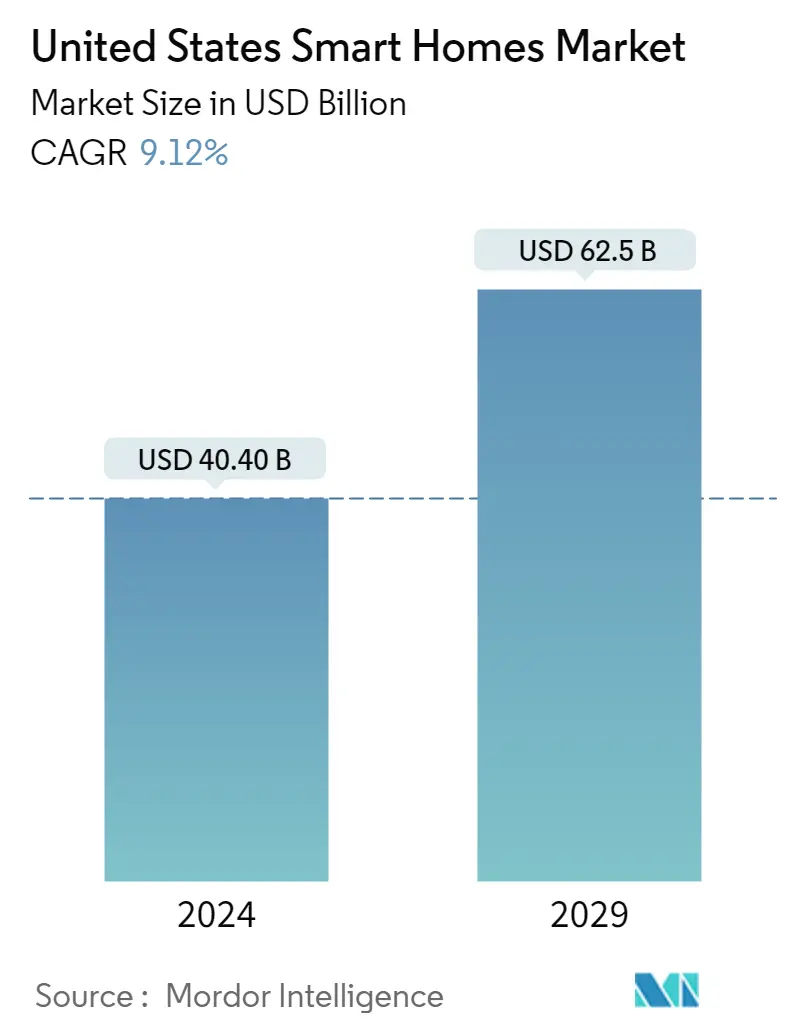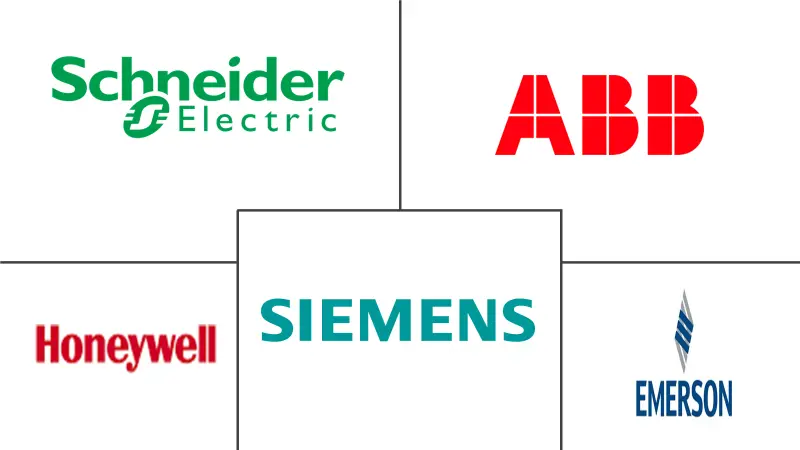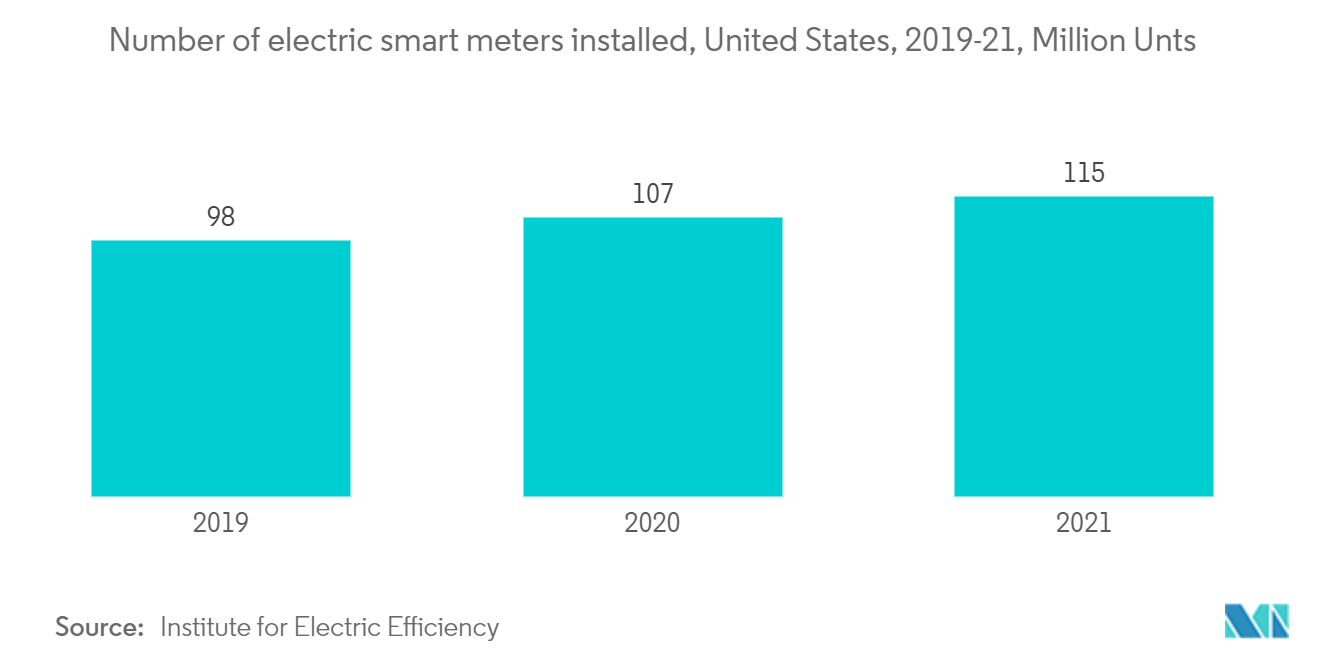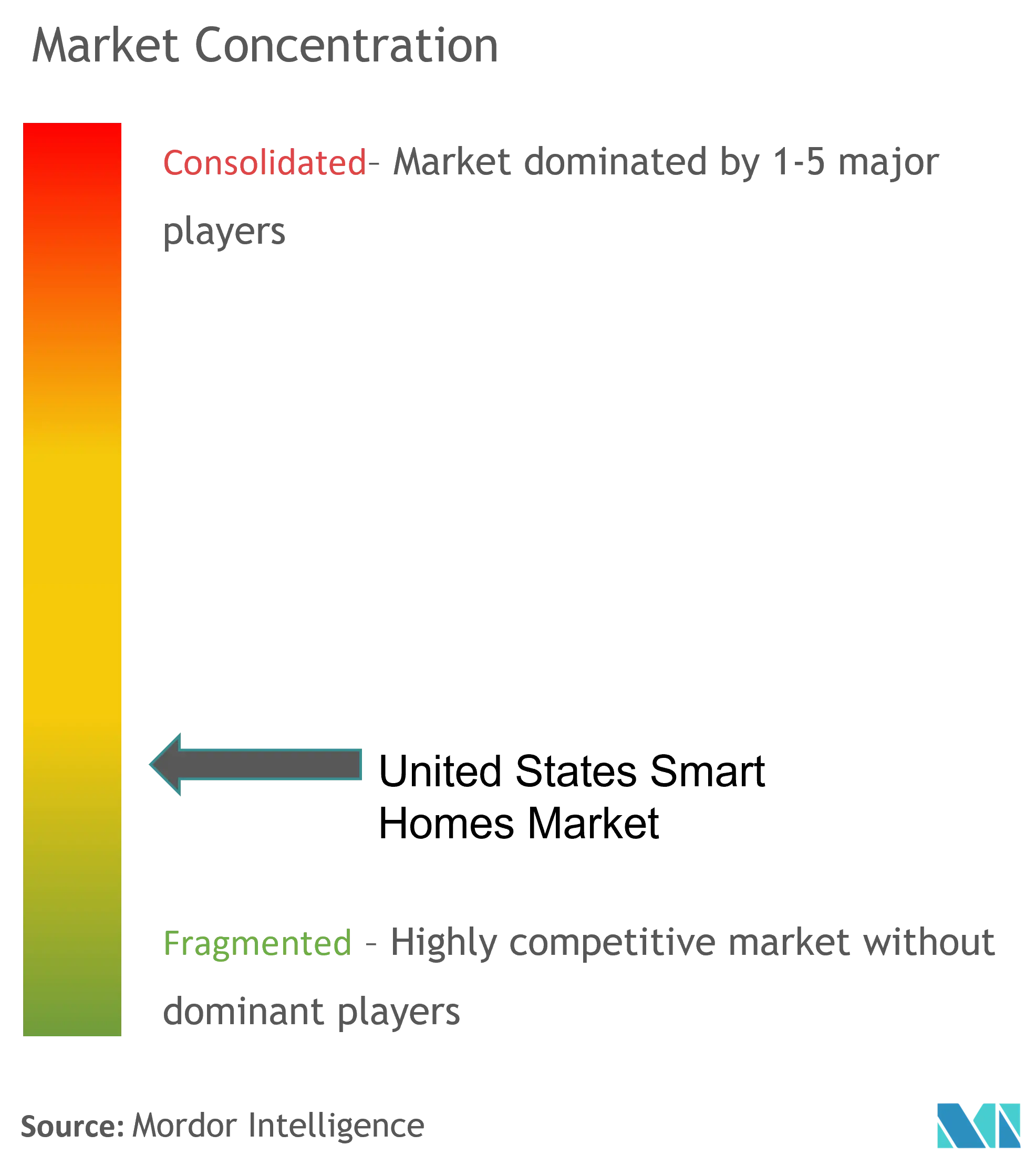United States Smart Homes Market Size

| Study Period | 2021 - 2029 |
| Base Year For Estimation | 2023 |
| Market Size (2024) | USD 40.40 Billion |
| Market Size (2029) | USD 62.50 Billion |
| CAGR (2024 - 2029) | 9.12 % |
| Market Concentration | Low |
Major Players
*Disclaimer: Major Players sorted in no particular order |
United States Smart Homes Market Analysis
The United States Smart Homes Market size is estimated at USD 40.40 billion in 2024, and is expected to reach USD 62.5 billion by 2029, growing at a CAGR of 9.12% during the forecast period (2024-2029).
Home automation and smart homes are two ambiguous terms used for a wide range of monitoring solutions that control and automate functions in a home. Unlike simple home automation solutions (which could range from motor-operated garage doors to automated security systems), smart home systems require a web portal or a smartphone application as a user interface to interact with a computerized system.
- The increasing importance of the need to counter security issues is anticipated to fuel the demand for smart and connected homes over the forecast period. Moreover, innovative wireless technologies, including security and access regulators, entertainment controls, and HVAC controllers, are expected to foster market growth. The recent advancements in the Internet of Things (IoT), which resulted in price drops for processors and sensors, are expected to encourage manufacturers to promote automation in the household sector.
- In an effort to include more sustainable energy resources, household energy management is receiving a growing level of attention. Further, to reduce their energy costs, homes must become more efficient due to growing energy prices and increased demand. With the help of the Home Energy Management System (HEMS), the enablement of energy management services for effective monitoring and management of electricity generation, power conservation, and energy storage techniques are being developed for smart homes.
- Some smart devices like smart thermostats and their associated apps can assist users in receiving faster alerts when a heating or cooling system is experiencing issues. When a home warms or cools past a preset temperature, some smart thermostats let the user set alarms, potentially signaling system issues. As opposed to using a conventional thermostat, this functionality enables users to schedule service for a damaged or malfunctioning system more rapidly.
- Currently, the smart homes market refers to luxury projects. However, it is expected to become a requirement in all housing categories. The educated population is increasingly migrating to urban areas in search of jobs. With the desire to own a house in sync with the current trends, several people living in urban locations aspire for smart homes or homes that can adapt to evolving technologies. The sector is witnessing prominent growth due to its various advantages. Apart from the luxury segment, homebuyers from multiple components are expected to begin opting for smart homes and their benefits, with home automation being offered at affordable prices.
United States Smart Homes Market Trends
This section covers the major market trends shaping the US Smart Homes Market according to our research experts:
Smart Appliances Accounted for the Highest Market Share
- Companies in the market have been focusing on improving food recognition and extending the same into their kitchen applications, such as full-size ovens and fridges. The majority of the trade shows across the past few years have observed the presence of ABB Limited, Emerson Electric Co., Siemens AG, and other emerging players in the smart home segment, launching concepts such as control over blinds and lights from a mobile device without needing additional wiring, remote monitoring of a stovetop, and integrating AI into appliances for recommendations.
- The role of a kitchen has evolved. It has evolved from a simple space for food preparation to be associated with activities such as entertainment, socializing, dining, and working. Technology has aided similar lifestyle changes. For instance, appliances are being designed to have added functionality to make them easier to use. This is one of the significant drivers for the adoption and development of smart and connectable appliances. Additionally, increased interest in cooking has been contributing to the growing adoption.
- Moreover, developments in the field of geofencing technology to determine smartphone locations to prevent leaving home without turning off an oven or receiving an alert to avoid accidental house fires are being observed. As per the New York City Fire Department, "unattended cooking" accounts for 33% of home fires on average. Moreover, it stated that the fire starter is attributed to when a stove or oven is near items that can catch fire, like paper towels, or when food or grease is left in the oven.
- A proprietary standard for home automation called Matter, formerly Project Connected Home over IP (CHIP) is royalty-free for manufacturers. Two years ago, Matter was launched in California, US, to reduce fragmentation among vendors and achieve interoperability between innovative home technology and Internet of Things (IoT) platforms from various suppliers. Amazon, Apple, Google, Comcast, and the Zigbee Alliance, now known as the Connectivity Standards Alliance, launched and introduced the project group to develop an open standard for smart home devices. The specification's first version, version 1.0, was released this year in October.

Energy Management to Witness the Fastest Growth
- Favorable government regulations and tax credit facilities for the installation of HVAC systems and the increasing focus of end users on reducing electricity bills have significantly contributed to the growth of the market studied.
- As per Project Drawdown, approximately 4-46% of households with internet access in the United States are expected to install a smart thermostat by 2050. This means that around 704 million homes would have a smart thermostat installed.
- The UEI TBH300 Smart Thermostat was launched this year by Universal Electronics Inc., one of the innovators in wireless universal control solutions for home entertainment and smart home devices. Ruckus Network's dedication to integrating with partners focused on green energy projects, including UEI's Energy Management Solution, within UEI's building network installation environment is shown in its integration with CommScope's RUCKUS. The UEI-connected thermostat offers consumers an immediate energy-saving option because it is a complete end-to-end solution with available sensors that can be incorporated into the RUCKUS wireless gateway using Zigbee technology. Once installed, it offers remote management features that help keep an eye on and manage the energy systems even when somebody is not there.
- Furthermore, most of these builders of large, planned communities offer various smart-home products like thermostats, lights, door locks, and garage openers as either standard equipment or available options. At the same time, smart appliances and water heaters are typically known as upgrades.

United States Smart Homes Industry Overview
The competitive landscape of the US smart home market shows market fragmentation. Some of the global key players in this market are ABB Limited, Schneider Electric SE, Honeywell International Inc., Emerson Electric Co., Siemens AG, LG Electronics Inc., Cisco Systems Inc., Google Inc., and Microsoft Corporation. Product launch, acquisition, and partnership are some of the key strategies adopted by market players operating in the market. For instance:
- In June 2022, Siemens AG launched Siemens Xcelerator, an open digital business platform, to accelerate digital transformation and value creation for customers of all sizes in industries, buildings, grids, and mobility. The business platform facilitates, accelerates, and scales digital transformation. Siemens has acquired Brightly Software, a leading asset, and maintenance management software company based in the United States. Brightly's well-established capabilities across key sectors will be added to Siemens' digital and software know-how in buildings. It will form the foundation of the Siemens Xcelerator for Buildings portfolio.
- In March 2022, Schneider Electric in Boston, USA, introduced the Wiser Gateway and Wiser Smart Plug, among the first products in the world to receive Matter certification, expanding the company's complete home energy management offering. The Wiser Gateway, the central communication interface for the larger Wiser ecosystem, and the Wiser Smart Plug, a small but critical transmitter for the Home Energy Management System (HEMS) network, are the first two products from Schneider Electric's holistic HEMS solution to incorporate the Matter Standard. It strengthens the company's position as a pioneer in developing home energy management systems that optimize energy usage and help reduce costs and residential carbon dioxide emissions while maintaining comfort.
United States Smart Homes Market Leaders
-
ABB Limited
-
Emerson Electric Co.
-
Honeywell International Inc.
-
siemens ag
-
Schneider Electric SE
*Disclaimer: Major Players sorted in no particular order

United States Smart Homes Market News
- November 2022: Various products and smart home systems can collaborate according to the Matter standard, which Amazon had stated plans to scale out. New WWA certification standards for Matter devices were introduced by Amazon this year. As they increase the dependability and functionality of linked devices, they will also enable innovation and choice.
- October 2022: Roku Inc. unveiled its brand-new line of smart home solutions, including plugs, lighting, security cameras, and video doorbells. Having a wider selection of straightforward and reasonably priced smart home products is made possible by Roku's product line development. Tens of millions of households utilize the Roku platform, and we are now expanding our ecosystem to include things like gadgets and services that power the modern smart home.
- October 2022: Google's Nest introduced a redesigned Google Home app, a wired doorbell, and the Nest wifi Pro with wifi 6E. The Nest Doorbell (wired, 2nd generation) has smarter features to provide you with greater peace of mind. It connects to your existing doorbell's wires, so there's no need to worry about charging it or running out of power-nest wifi Pro router, a new high-performance tri-band wifi 6E mesh router system. Users of Nest wifi Pro will gain access to the all-new 6 GHz radio band, enabling wifi to be up to twice as fast as wifi 6.
United States Smart Homes Market Report - Table of Contents
1. INTRODUCTION
- 1.1 Study Assumptions and Market Definition
- 1.2 Scope of the Study
2. RESEARCH METHODOLOGY
3. EXECUTIVE SUMMARY
4. MARKET INSIGHTS
- 4.1 Market Overview
-
4.2 Industry Attractiveness - Porter's Five Forces Analysis
- 4.2.1 Bargaining Power of Suppliers
- 4.2.2 Bargaining Power of Consumers
- 4.2.3 Threat of New Entrants
- 4.2.4 Threat of Substitute Products
- 4.2.5 Intensity of Competitive Rivalry
- 4.3 Assessment of Impact of COVID-19 on the Market
-
4.4 Technology Snapshot
- 4.4.1 Bluetooth
- 4.4.2 Wi-Fi
- 4.4.3 GSM/GPRS
- 4.4.4 ZigBee
- 4.4.5 RFID
- 4.4.6 Z-Wave
- 4.4.7 Smart Speakers
- 4.4.8 Control Devices
5. MARKET DYNAMICS
-
5.1 Market Drivers
- 5.1.1 Increasing Demand for Energy-efficient Solutions
- 5.1.2 Growing Need for Automation of Security Systems
-
5.2 Market Restraints
- 5.2.1 High Installation and Replacement Costs, along with Privacy Concerns
6. MARKET SEGMENTATION
-
6.1 By Product Type
- 6.1.1 Comfort and Lighting
- 6.1.2 Control and Connectivity
- 6.1.3 Energy Management
- 6.1.4 Home Entertainment
- 6.1.5 Security
- 6.1.6 Smart Appliances
7. COMPETITIVE LANDSCAPE
-
7.1 Company Profiles
- 7.1.1 ABB Limited
- 7.1.2 Schneider Electric SE
- 7.1.3 Honeywell International Inc.
- 7.1.4 Emerson Electric Co.
- 7.1.5 Siemens AG
- 7.1.6 LG Electronics Inc.
- 7.1.7 Cisco Systems Inc.
- 7.1.8 Google Inc. (Alphabet Inc.)
- 7.1.9 Microsoft Corporation
- 7.1.10 GE Appliances (Haier Group)
- 7.1.11 Legrand SA
- 7.1.12 Lutron Electronics Co. Inc.
- 7.1.13 Whirlpool Corporation
- 7.1.14 Smart Home Inc.
- 7.1.15 Smart Home Inc.
- 7.1.16 Control4 Corporation
- 7.1.17 Savant Systems Inc. (GE Lighting)
- *List Not Exhaustive
8. INVESTMENT ANALYSIS
9. FUTURE OF THE MARKET
** Subject To AvailablityUnited States Smart Homes Industry Segmentation
Smart home devices are suitable for a home setup where devices can be automatically controlled remotely from any internet-connected place, using a mobile or other networked device. A smart home has devices connected through the internet, and the customer can regulate functions, such as security access to the house, temperature, lighting, and home theater. The scope of the market includes various smart home segments as below: energy management, comfort and lighting, home entertainment, control and connectivity, security, and smart appliances.
The United States smart home market is segmented by product type (comfort and lighting, control and connectivity, energy management, home entertainment, security, and smart appliances).
The market sizes and forecasts are provided in terms of value (USD million) for all the above segments.
| By Product Type | Comfort and Lighting |
| Control and Connectivity | |
| Energy Management | |
| Home Entertainment | |
| Security | |
| Smart Appliances |
United States Smart Homes Market Research FAQs
How big is the United States Smart Homes Market?
The United States Smart Homes Market size is expected to reach USD 40.40 billion in 2024 and grow at a CAGR of 9.12% to reach USD 62.50 billion by 2029.
What is the current United States Smart Homes Market size?
In 2024, the United States Smart Homes Market size is expected to reach USD 40.40 billion.
Who are the key players in United States Smart Homes Market?
ABB Limited, Emerson Electric Co. , Honeywell International Inc., siemens ag and Schneider Electric SE are the major companies operating in the United States Smart Homes Market.
What years does this United States Smart Homes Market cover, and what was the market size in 2023?
In 2023, the United States Smart Homes Market size was estimated at USD 37.02 billion. The report covers the United States Smart Homes Market historical market size for years: 2021, 2022 and 2023. The report also forecasts the United States Smart Homes Market size for years: 2024, 2025, 2026, 2027, 2028 and 2029.
US Smart Home Industry Report
Statistics for the 2024 US Smart Home market share, size and revenue growth rate, created by Mordor Intelligence™ Industry Reports. US Smart Home analysis includes a market forecast outlook to 2029 and historical overview. Get a sample of this industry analysis as a free report PDF download.



